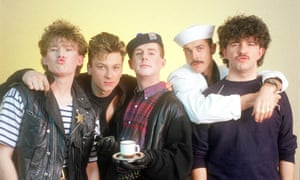How we made: Relax by Frankie Goes to Hollywood
‘The Sex Mix got so many complaints – even some gay clubs found it offensive’

I wanted to be provocative with the way Frankie Goes to Hollywood looked and for the lyrical content to be modern and edgy. We had been living through a politically charged time, the Sex Pistols and Bow Wow Wow had made headlines, and I knew we had to do the same to make an impact. I had a vision of something that merged punk and disco. I was always badgering the drummer to just play a four-on-the-floor bass drum.
Relax was written in my head, and I sang it out loud to myself walking down the middle of Princes Avenue in Liverpool, laughing as I went. Beggars Banquet offered us each £40 a week for the next year, but we signed to ZTT. This proved to be a very expensive choice. We all had to sign on the dole because ZTT were tight with money, unless they were spending it on our behalf in their own studios. Their only asset was Trevor Horn at his peak, which was a big carrot waved in front of our donkey.
We were booked into the Manor Studio to record it. The sound of us jumping into the swimming pool was sampled into [computer/synthesiser] the Fairlight – the only thing that survived those sessions. Trevor didn’t like the band’s standard of playing as he couldn’t sync it to his machinery, which was fairly cutting edge at the time. Unlike the other members, I attended many of the studio sessions so I wasn’t surprised by the final version after he scrapped three or four others.
ZTT celebrated Relax being banned by the BBC, as it went to No 1 in the UK shortly afterwards. We had already performed it on The Tube and Top of the Pops’ 20th anniversary show, which catapulted the single up the charts, but were unable to play Top of the Pops when Relax reached its peak position. This was a disappointment as it was every young kid’s dream to appear on that show with a No 1.
I try not to look back on this period too much, but am aware Frankie Goes to Hollywood is the lens I’ll always be viewed through. It was the perfect pop moment, which sparked the age of multiple dance remixes that are obligatory for today’s digital pop and dance artists.
Relax took six weeks to record. The band we signed weren’t quite the band who had appeared on the original demo, though we didn’t know that at the time. The original guitarist was the bass player Mark O’Toole’s brother, Jed, but he had to leave and get a day job. Brian Nash came in, but had only just learned how to play. By the time we finished Welcome to the Pleasuredome, he was good. But that’s why I hired [Ian Dury’s backing band] the Blockheads – I needed to try the track with some other musicians, to see if there was anything else we could do with it.
On the final single version, I was recording with three brilliant people: Steve Lipson, Andy Richards and JJ Jeczalik. We were all frustrated because it felt like we were going nowhere. I admitted defeat. Sometimes when you do that and give it one more go, you get lucky. All the work we had put into these different versions suddenly coalesced.
The Fairlight had a program called Page R. This was the first time you could sequence natural sounds, which was a huge step forward. I could program a drum machine perfectly in sync with the piano. I was working the drum machine and was manually switching between patterns on the fly and singing a guide vocal. Steve was playing guitar, Andy keyboards and JJ working the Fairlight. We had to work for hours to get to a point where we could record it. We put our heads down and got it first take.
Hit singles are not just good songs. They need to be moments. Holly had been blowing his saxophone on the studio roof in Notting Hill at 2am, and a bunch of guys appeared on the street, calling up to him. He came down to do the vocal, and I suggested he play it at the start of Relax. That’s one of the first sounds you hear. In my imagination, he was among minarets on top of a temple playing to a crowd below as they all moved towards him in time with the music.
I was in New York working with Foreigner when I realised how risque Relax was. Paul (Morley) sent over the video on VHS cassette. The guys from Foreigner, who didn’t like me much anyway, wanted to see it. They thought it was disgusting.
About a week later, I went to [New York club] Paradise Garage for the first time. It was amazing. They had this massive sound system. We were getting so many complaints about the Sex Mix, including from gay clubs which found it offensive, that I decided to do another 12-inch, something more ambitious with material that wasn’t on the original. The New York Mix made a big difference because it started getting played in clubs. That was a gamechanger.
Frankie Say 1984! is at the British Music Experience, Liverpool, until 9 January.



